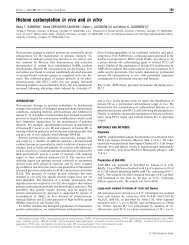Full Text PDF - Biochemical Journal
Full Text PDF - Biochemical Journal
Full Text PDF - Biochemical Journal
Create successful ePaper yourself
Turn your PDF publications into a flip-book with our unique Google optimized e-Paper software.
498 D. M. Williams and othersFigure 3Yeast two-hybrid assays, SEC coupled with MALLS, far-UV CD spectra and DLS of WT 14-3-3ζ and 15C 14-3-3ζ(A) The ability of WT and 15C 14-3-3ζ to interact with the bait proteins Raf-1, Bad and S136A Bad in a yeast two-hybrid assay. Triplicate samples were used for this experiment and error barsindicate S.D. The results shown are representative of three individual experiments. (B) SEC coupled with MALLS illustrating the increase of 15C 14-3-3ζ ’s elution volume and reduction in massrelative to WT 14-3-3ζ . The continuous line represents UV absorption at 280 nm and circles represent the molecular mass of each protein obtained as a function of their elution volume. (C) Thefar-UV CD spectra of WT (continuous line) and 15C (broken line) 14-3-3ζ illustrating the decreased α-helical structure of the truncated protein at 37 ◦ C, as denoted by the decreased minima at208 and 222 nm relative to that of WT 14-3-3ζ .(D) DLS profiles of WT (left-hand panel) and 15C (right-hand panel) 14-3-3ζ at 25 ◦ C and 37 ◦ C, where the eluted particle size distribution isshown by number and demonstrates the propensity of 15C 14-3-3ζ to aggregate with time at 37 ◦ C.the involvement of the C-terminal extension of 14-3-3ζ in itsthermostability in more detail. The alteration in structure of fulllengthand truncated 14-3-3ζ as a function of temperature (37–80 ◦ C) was assessed by intrinsic fluorescence of the tryptophanresidues (at positions 59 and 228). The wavelength of maximumtryptophan fluorescence emission (340 nm) was the same for boththe WT and truncated protein and, over the temperature rangetested, the emission profile did not undergo a red or blue shiftfor either protein (results not shown). Thus, over the temperaturerange examined, removal of the C-terminal extension of 14-3-3ζ does not significantly alter the environment of the tryptophanresidues within the protein.The change in light scattering at 360 nm, as a functionof temperature for WT and 15C 14-3-3ζ , was measured(Figure 4A). Initially both proteins were relatively stabledisplaying no significant alteration in light-scattering propensitybetween 37 ◦ C and 56 ◦ C. At 56 ◦ C, the 15C 14-3-3ζ solutionunderwent a marked increase in turbidity indicating significantaggregation of the protein. A second increase in turbidity occurredat 74 ◦ C. The WT protein, on the other hand, displayed nochange in light scattering until 60 ◦ C after which there was aslight increase. The precipitation profile for WT 14-3-3ζ was alsobiphasic with a substantial increase in precipitation at 82 ◦ C.The light-scattering data suggest that C-terminal truncation of14-3-3ζ decreases its thermostability and hence its C-terminalextension contributes to the stability of the protein. In agreementwith this, the far-UV CD-melting profiles also indicated thatthe truncated protein had decreased thermostability relative to theWT protein, as quantified by a decrease in α-helical content ofboth proteins at 222 nm with increasing temperature due tounfolding and aggregation (Figure 4B). These data indicated that15C 14-3-3ζ began to lose α-helical content at 32 ◦ C, whereasthis did not occur until approximately 37 ◦ C for the WT protein.The melting points of the 15C and WT proteins determinedfrom the CD data were 56 ◦ C and 60 ◦ C respectively, and weredirectly comparable with the temperatures at which aggregationwas observed by light scattering (Figure 4A). These data are alsoconsistent with the DLS data in Figure 3(D) which highlight thec○ The Authors <strong>Journal</strong> compilation c○ 2011 <strong>Biochemical</strong> Society








